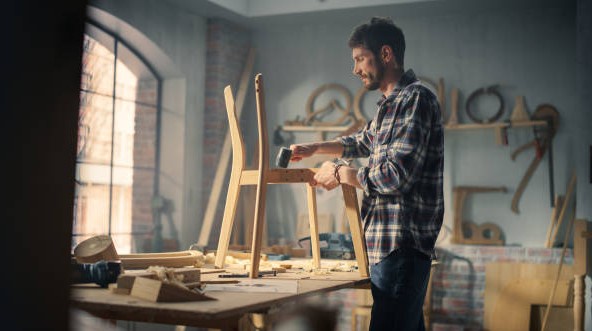Furniture restoration is a captivating endeavor that combines creativity with a dash of nostalgia. Whether you're a seasoned restoration enthusiast or a newcomer to the world of reviving furniture, one of the crucial aspects is evaluating the value of the pieces you're considering for restoration. In this article, we'll explore a comprehensive guide on how to assess the worth of furniture for restoration projects. From antique treasures to mid-century modern gems, each piece has a story to tell and potential to shine once again.
Understanding the Basics
Before delving into the nitty-gritty of evaluating furniture for restoration, it's essential to have a solid understanding of the basics. Begin by identifying the type of wood used, the overall condition of the piece, and any distinctive features that make it unique. Is it a classic Victorian armchair or a sleek mid-century coffee table? Knowing the basics helps set the foundation for a successful restoration project.
Examining the Wood
Wood is the soul of any piece of furniture. To evaluate its potential for restoration, start by examining the type of wood used. Hardwoods like oak and mahogany are often more durable and desirable for restoration projects. Check for signs of rot, termite damage, or warping, as these issues can significantly impact the feasibility of restoration.
Assessing Structural Integrity
The structural integrity of a piece is paramount when considering furniture restoration. Wiggle the legs, inspect joints, and check for any wobbliness. Sturdy, well-constructed furniture is more likely to withstand the restoration process and serve its purpose for years to come. Pay attention to any missing or loose hardware, as these can be replaced or repaired during the restoration. Additionally, it's crucial to explore relevant resources or guides on the subject, particularly on a reputable website, to enhance your knowledge and skills in effective furniture restoration.
Evaluating Aesthetic Appeal
Once you've determined the foundational aspects, shift your focus to the aesthetic appeal of the furniture. After all, a restored piece should not only be functional but also visually appealing.
Scrutinizing Finishes and Surfaces
The current state of the finish and surfaces can provide valuable insights into the overall condition of the furniture. Are there layers of peeling paint or varnish? Is the original finish still intact beneath the layers of neglect? A piece with a well-preserved finish might require less effort in restoration compared to one with extensive damage.
Noting Unique Design Features
Every piece of furniture has its own unique design elements that contribute to its charm. Take note of intricate carvings, ornate details, or innovative design features. These distinctive qualities not only add value but also make the restoration process more rewarding. Highlighting these features can enhance the overall appeal of the finished project.
Boldly Going Beyond: The Second Table
Now, let's talk about adding a touch of flair to your restoration journey. Imagine you've stumbled upon a neglected table, and you're ready to assess its potential. In the world of markdown language, bolding the heading of the second table is as simple as wrapping it with double asterisks. For example, like this. This small formatting trick can emphasize the importance of the second table and draw the reader's attention.
Gauging Historical Significance
Certain pieces of furniture carry historical significance, making them valuable not only for their aesthetic appeal but also for their connection to a specific era or style.
Researching the Manufacturer
Digging into the history of the furniture's manufacturer can unveil interesting details. Was it crafted by a renowned furniture maker from the past? Does it belong to a particular design movement or period? Such information can elevate the value of the piece and make the restoration process even more meaningful.
Identifying Period-specific Features
Different eras brought forth distinct design trends and features. From the Art Deco elegance of the 1920s to the minimalist simplicity of the 1960s, identifying period-specific elements can guide your restoration efforts. Restoring a piece to its original glory ensures that it remains a faithful representation of its historical context.
Balancing Cost and Investment
While passion fuels the world of furniture restoration, it's crucial to strike a balance between cost and investment. Assessing the value of a piece includes considering the expenses involved in the restoration process.
Budgeting for Restoration
Before embarking on a restoration project, outline a budget that encompasses materials, tools, and any professional services you may require. This ensures that the joy of restoring a piece doesn't transform into financial strain.
Calculating Potential Return on Investment
Consider the potential return on investment when restoring a piece. Some furniture, when carefully and skillfully restored, can fetch a higher price in the market. Factor in the time and effort invested, along with the potential market value, to make informed decisions about your restoration projects.
The Thrill of Restoration
In the world of furniture restoration, each project is a unique adventure waiting to unfold. The thrill lies not only in the finished product but also in the journey of bringing a forgotten piece back to life. Embrace the imperfections, celebrate the history, and relish the satisfaction of turning neglected furniture into cherished gems.
As you evaluate the value of furniture for restoration projects, let your passion guide you. From examining wood grains to exploring historical contexts, each step contributes to the story of revival. So, grab your tools, put on your creative hat, and embark on a restoration journey that transforms forgotten pieces into timeless treasures.


No comments yet